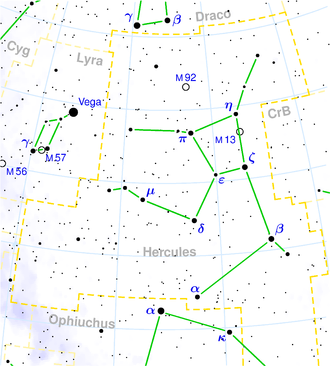NGC 6175
| Galaxy NGC 6175 |
|
|---|---|

|
|
| SDSS recording | |
| AladinLite | |
| Constellation | Hercules |
|
Position equinox : J2000.0 , epoch : J2000.0 |
|
| Right ascension | 16 h 29 m 57.9 s |
| declination | + 40 ° 37 ′ 45 ″ |
| Appearance | |
| Morphological type | 1: S0 2: E0 |
| Brightness (visual) | 1: 13.7 mag 2: 14.0 mag |
| Brightness (B-band) | 1: 14.7 mag 2: 15.0 mag |
| Angular expansion | 1: 1.3 ′ × 0.8 ′ 2: 0.6 ′ × 0.6 ′ |
| Position angle | 1: 92 ° |
| Surface brightness | 1: 13.6 mag / arcmin² 2: 13.0 mag / arcmin² |
| Physical data | |
| Affiliation | Abell 2197 |
| Redshift | 0.029360 |
| Radial velocity | 8802 km / s |
|
Stroke distance v rad / H 0 |
(401 ± 28) · 10 6 ly (122.8 ± 8.6) Mpc |
| history | |
| discovery | Wilhelm Herschel |
| Discovery date | March 18, 1787 |
| Catalog names | |
| NGC 6175 • UGC 10422 • PGC 58362 • CGCG 224-050 • MCG + 07-34-87 • GC 4214 • H III 641 • h 1963 • | |
NGC 6175 is a radio galaxy that consists of two colliding smaller galaxies: NGC 6175-1 is a 13.7 mag bright, lens-shaped galaxy of the Hubble-type S0; NGC 6175-2 is a 14.0 mag bright, elliptical, Hubble-type E0 galaxy . NGC 6175 is located in the constellation Hercules and was discovered on March 18, 1787 by Wilhelm Herschel with an 18.7-inch reflector telescope, who described it as "vF, vS".
Web links
- NGC 6175.SIMBAD , accessed June 14, 2016 .
- NGC 6175. DSO Browser, accessed June 14, 2016 .
